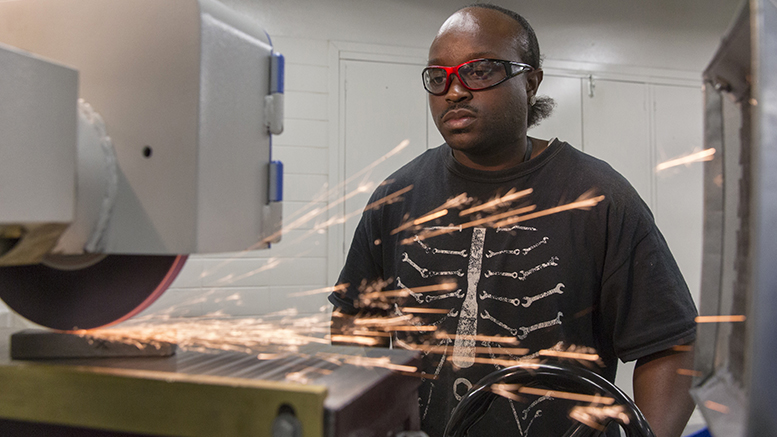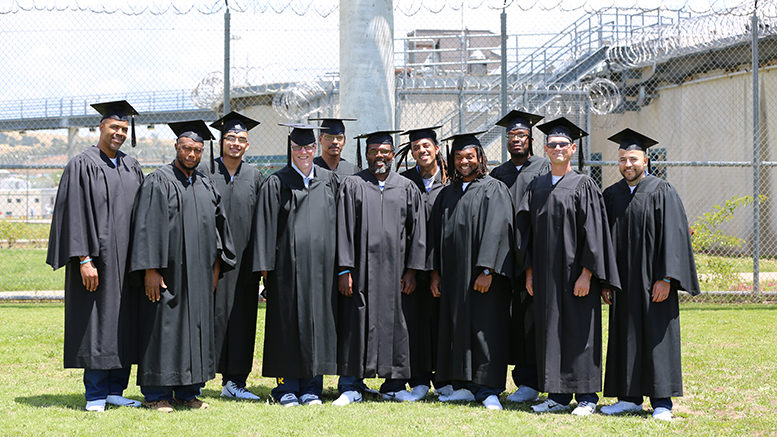Congress in December lifted a ban that, since 1994, has prevented access to Pell grants for people in prison. That means nearly half a million inmates could be eligible for Pell, according to the Vera Institute for Justice.
Most people in prison come from a situation where they likely were eligible for Pell and will be eligible again when they leave, but banning access to Pell while people are incarcerated is a missed opportunity, says Ruth Delaney, a Vera Institute program manager.
“Time in prison can be a time when people are looking for a new path. College offers a new avenue for that,” she says.
Besides reducing recidivism rates, college programs in prisons also can boost economic mobility for people from marginalized communities.
“People going to prison are most likely coming from really impoverished backgrounds,” Delaney says.
About one-third of prisoners in the United States are Black, and nearly a quarter are Hispanic/Latino. Offering access to education “brings opportunity to a place where concentrated inequity exists,” she adds.
In 2015, the federal government launched the Second Chance Pell (SCP) Pilot Program to help qualifying inmates earn a degree while incarcerated. Sixty-four higher education institutions – many of them two-year, public colleges – were named “experimental sites” as part of that pilot program, working with penitentiaries to deliver education to prisoners.
Data from SCP shows the impact educational access can have. According to data released in April by the Vera Institute, which has provided technical assistance to SCP colleges and corrections departments, SCP colleges have enrolled nearly 17,000 people over three years. Those students have earned more than 4,500 certificates, postsecondary diplomas, associate degrees and bachelor’s degrees.
In 2020, an additional 67 institutions were invited to participate as experimental sites – 45 of which were two-year colleges.
Part of their mission
Milwaukee Area Technical College (MATC) was named an experimental site in the 2015 launch of Second Chance Pell. In 2017, the college started offering distance learning courses leading to degrees for Wisconsin Department of Corrections (WIDOC) students.
“Milwaukee Area Technical College’s mission is transforming lives, industry and community, and educating incarcerated individuals helps us do all three at once,” says Sadique Isahaku, dean of MATC’s general education academic & career pathway and administrator of correctional education services.
The college is currently providing postsecondary educational opportunities in 12 correctional institutions across the state. Most classes are still delivered remotely, though an in-person welding program has been added. In addition to classes, students have support from WIDOC education coordinators, directors and teachers. They also have direct “online” communication with their MATC instructors and receive one-on-one academic advising each semester, according to Isahaku.
The college plans to expand into more academic programs to meet the interests and demand of students, employers and other stakeholders.
“MATC believes that the postsecondary educational opportunities contribute to the students transforming their lives and prepare them for family-sustaining jobs post-release; while helping area businesses fill their skilled worker job openings,” Isahaku says.
Expanding access to Pell for prisoners will help with that.
“We anticipate that the DOC will allow us to enroll more students from more prisons where we currently do not offer any programs,” Isahaku adds. “We also anticipate that other higher education institutions may explore offering programs.”
Another Wisconsin college – Madison College – is part of the second round of Second Chance Pell.
A system-wide approach
MATC and Madison College are just two of the many colleges in the state to work with prisons. Since 2017, 11 of the 16 colleges in the Wisconsin Technical College System (WTCS) have provided education services to 25 of the 27 state prisons. Annually, more than 30,000 credits are awarded to over 6,000 individuals.
Building education programs in prisons means exploring partnerships, programming and “how can we come in with useful tools that will give offenders the same quality education that one would receive if they weren’t in prison,” says Lenard Simpson, WTCS education director for justice-involved populations.
Pell grants are important because “access to programs and cost are obstacles for offenders,” Simpson says. “They cause people to be disconnected from career opportunities.”

The success of those programs depends on collaboration with the state department of corrections and local workforce development agencies.
Though each college tailors its curriculum to its locality and the needs of its partners, through a system-wide approach, “institutions are helping each other and better helping students who may move to other parts of the state after release,” Simpson says. “We come together and serve population collectively.”
During the pandemic, they are leveraging technology and using distance learning when possible so classes can continue.
“The pandemic is already a traumatic event; pausing someone’s education shouldn’t be added to that trauma,” Simpson says.
He adds that people leaving prison soon will vie for jobs in a post-pandemic workforce against people in the outside world.
“The education someone has can convince an employer to hire that person with a criminal record,” he says.
Opening doors
In Kentucky, Big Sandy Community and Technical College (BSCTC) has its “foot in the door” with prison education at the nearby federal penitentiary, but President Sherry Zylka hopes to open that door wider. The college offers some courses to people in prison as part of its mission to serve the community. BSCTC isn’t part of the Second Chance Pell pilot program, so it isn’t receiving any tuition funding.
“It’s an investment we’re willing to make in our community. It’s about giving back,” Zylka says.
Though the college can’t afford to provide as many educational opportunities to prisoners as Zylka would like, “We’re committed to social justice.”
Not only does providing college courses help student inmates get a career after they leave the facility, “it gives them hope,” she adds.
Zylka has kept an eye on Second Chance Pell for a while. Allowing prisoners to access Pell grants will allow expanded opportunities for both the college and inmates. It’ll also help to strengthen BSCTC’s “fledgling” relationship with the department of corrections, she says.
Making it intentional
Folsom Lake College (FLC) with its sister colleges has served 1,293 students inside of prisons, jails and detention facilities since 2016. This semester, despite the pandemic, FLC has 21 instructors teaching 33 courses in 12 different disciplines to students in three facilities. Courses are provided not only for people nearing release, but also for people with life sentences.
It’s all part of serving the community, says Mariko Peshon, dean of FLC’s Prison and Reentry Education Program.
“Our prisons and jails are very much part of our communities, they’re just on the margins. We’re taking it to the margins, rather than them coming to us,” she says.
The college isn’t part of the Second Chance Pell pilot program, but California allows offenders meeting certain criteria to access the California College Promise Grant. If offenders don’t qualify, they can apply for federal funding, but some have waited for years to access to Pell.
Opening access to Pell will not only increase the amount of incarcerated people in California pursuing higher ed; it also will provide them more resources to access transfer pathways so they can build on their education plans, Peshon says.
Related article: Prison education adapts to pandemic challenges
There’s another big benefit to correctional education in California: Through state legislation, students can earn time off their sentence for every college course they successfully complete, “which has a direct impact on community and statewide savings, not to mention the contributions our students are making in their communities upon return,” she says.
There’s a benefit to faculty, too. Faculty who teach in correctional facilities become more empathetic and report being better instructors on campus. According to Peshon, it’s important to remember that “everyone in the correctional facility is someone’s child, just like on campus.”
The program through FLC was created very intentionally. The college has worked to align all instructional services on-campus with services at the prisons. For colleges interested in creating correctional education programs, Peshon advises, “Never try to modify.” There’s a difference between modification and accommodation, she says.
“We’re not modifying our standards. We’re accommodating how they get there,” she says.
Relationships need to be intentional, too. On the college campus, faculty, admissions and records, financial aid and counseling all work together to provide support for students.
Related article: Starting a prison program calls for detailed planning
“We mirror the strength of those relationships with our correctional partners,” Peshon says. “We think about creating a relationship that can help us move forward and will help hold us accountable.”
And it’s working.
Students in correctional facilities often outperform students on campus, despite the fact they have multiple jobs, sleep in communal settings and don’t have access to Google. Correctional education programs also have reduced recidivism in California.
“We’re coming in and providing education from a community mindset,” Peshon says. “We’re creating a different culture.”

